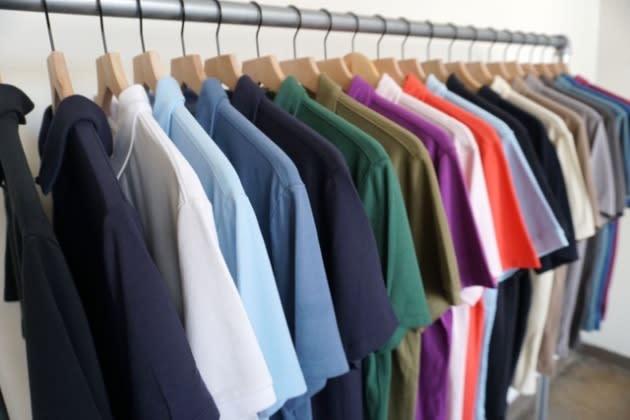Packing a Lot Into a Polo

Does the world need another polo shirt?
Perhaps if it’s luxurious to the touch and produced with natural and recycled materials, including crab shells and jade stone.
More from WWD
“Feel the fabric. It’s very soft, but there is also a coolness to it,” said Chris Kolbe, showing one of his new polo shirts under the brand name HyperNatural. He plans to launch the Hypernatural collection of polo shirts for spring 2023 with a limited distribution at upscale independent men’s specialty stores and golf shops. The focus is on wholesaling but an e-commerce website is also in the works.
Kolbe and Christian Arkins are cofounders of HyperNatural, a self-funded start-up utilizing a more scientific and sustainable formula for creating men’s polo shirts. During an interview at the HyperNatural offices on West 38th Street in Manhattan, the two entrepreneurs said their polos are made from Supima cotton for extra softness and less pilling due to its extra-long staple fiber; jade stone for a cooling quality; chitin, a biopolymer from crab and prawn shells that’s anti-microbial for odor resistance; natural plant dyes instead of chemical dyes for colors, and recycled Creora Regen Spandex for stretch, which is new and expensive and the only non-natural element in the garment.
“We took Supima cotton, which is the very best cotton in the world, and mixed it with jade stone, which is the waste from jade mining. It’s repurposed waste,” Kolbe said. “Jade stone has properties of cooling. There is a natural coolness to the touch but it also regulates your skin temperature three to five degrees cooler than if you didn’t have it.”
The chitin, aside from its odor resistance, moisturizes the skin, reduces inflammation and supports skin regeneration and healing, Kolbe claimed. “We have worn these shirts for several days in a row to a week and there is no body odor. You don’t have to wash it as much. It naturally stays fresh. The cooling and anti-odor will not wash out over time, because the jade stone and chitin are part of the fibers in the yarn.
“There is no material like this in the world.”

For season one, the polos are being offered in two fabrics, micro pique and featherweight jersey; two fits, classic and slim, and 29 colors, all solids. Details include mother-of-pearl buttons, tight stitching on the collar to keep it from flapping, and an inside pocket that’s actually a lens cleaner for eyeglasses. The design is very clean; there are no hangtags.
The logo is a magpie bird, which is considered one of most intelligent creatures. “It recognizes itself in the mirror, like a gorilla or a dolphin. It has that kind of intelligence,” Kolbe said. “It’s also really beautiful.
“HyperNatural polos are based on the awesomeness of nature,” said Kolbe, a product and branding executive who has held senior positions at Belk, Kohl’s, Lands’ End, Lucky Brand Jeans, Mexx Europe and Original Penguin. “We set out two years ago to make the best polo shirt in the world, the Tesla of polo shirts.”
It’s a luxury product, Arkins added, considering its lighter footprint on the environment, and justifiably higher prices set at $135 for the featherweight jersey polo; $165 for micro pique polo, and $195 in heavyweight pique. Prices are a rung below designer label polos, which generally run around $200.
“I’ll be honest with you, this a very expensive fabric,” Kolbe said. “Most [companies] could not afford to make it, let alone figure out how to make it.
“It’s a different perception of what luxury is and that is what we are coming at it with — using nature to define luxury,” added Arkins, who has extensive marketing, design and digital expertise, and worked with Kolbe at Original Penguin. “The ultimate result is ‘hyper-comfort’ and very easy care.”
“We did a lot of research, worked with material scientists, started with raw materials, turn them into yarns and turned the yarns into fabric,” Kolbe explained. “To make something really different you have to go to that raw material level, which takes a couple of years of development. We took the best cotton in the world, which is Supima, and we created some other things that give the polos natural performing characteristics of cooling and anti-odor that you typically get from chemicals, and it has the comfort that people expect.”
Kolbe said the brand “did a lot of research, worked with material scientists, and one of our partners is the actual mill” to develop the fabric. “We’re making these polos out of China because that’s where all the waste comes from. The jade stone, the crab shells and the scrap cotton we use to make the viscose yarn are all coming from regenerated material.”
While about half of the composition of the polos is regenerated materials, the other half is American-grown Supima cotton. “Together, you have a cocktail of fibers that gives you this whole different level of performance.”
“We started with something utilitarian — the polo shirt — everybody has them. But if you make the best one and it’s natural and it performs, we can make polyester more obsolete. Polyester is really the enemy. About 75 percent of apparel is made with petrochemical materials.
“There is this kind of bio, technical revolution happening with natural materials and it’s going to change over the next 10 years, you are going to see people use seaweed and algae, that brings micro nutrients to your skin,” Kolbe said. “HyperNatural is based on taking things that are natural and aligning them with science in a way that’s amazing.”
For now, HyperNatural is keeping it simple, with just polos in two fabrics, two fits and one material story. Other products with the HyperNatural material story could be developed. “It could be undergarments, it could be bedding,” Kolbe said. “Anything that touches your skin is within our reach.”

 Yahoo Movies
Yahoo Movies 